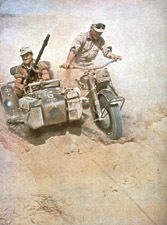Q: A close friend of mine is restoring a World War II cavalry motorcycle. It’s from Fort Sheridan in Illinois toward the end of World War II. We cannot, however, find a record of the cavalry unit or company that used these bikes.
—Anne Friedman
Lake Forest, Ill.
A: Unfortunately, it’s impossible to identify the unit from only the make or model. There were no motorcycle cavalry regiments in the U.S. Army. Rather, motorcycles were distributed to divisions and regiments throughout the armed forces to be used as improvised ambulances or for reconnaissance, dispatch, and personal transport.
The motorcycle was first adopted by the U.S. Army in 1913 and got the ultimate seal of approval in 1916, when Brigadier General John J. Pershing made it part of his expeditionary force that hunted Pancho Villa in Mexico. About 20,000 were used during World War I, including one-third of Harley-Davidson’s production and all of Indian Motorcycle Manufacturing Company’s inventory for 1917 and 1918. (Indian would regret its military focus in the postwar years, when Harley-Davidson far outstripped its civilian sales.)
A motorcycle dispatch rider, Corporal Roy Holtz, was the first American to enter Germany after the armistice. He crossed the border on November 12, 1918, riding a Harley-Davidson.
 In World War II, the U.S. armed forces used about 90,000 motorcycles, virtually all Harley-Davidsons, while Canadian, Australian, and other British Commonwealth forces tapped the 30,000 Indian motorcycles produced in 1942 and 1943.
In World War II, the U.S. armed forces used about 90,000 motorcycles, virtually all Harley-Davidsons, while Canadian, Australian, and other British Commonwealth forces tapped the 30,000 Indian motorcycles produced in 1942 and 1943.
The number of military motorcycles dwindled toward the end of the war, however, as Americans concluded that the jeep could perform most of the cycles’ tasks just as well.
Several other motorcycle makes gained renown during the war, including BMW, Triumph, and Zundapp. Germans stormed enemy objectives riding BMWs with sidecars that mounted MG 34 or MG 42 light machine guns. BMW also produced a specialized version, the R75, to withstand the desert conditions that faced Germany’s Afrika Korps.
—MHQ research director Jon Guttman is the author of several books on military history.
Is there anything about military history you’ve always wanted to know? Submit your question to MHQeditor@weiderhistory.com. You can even suggest the expert you’d like us to query.





